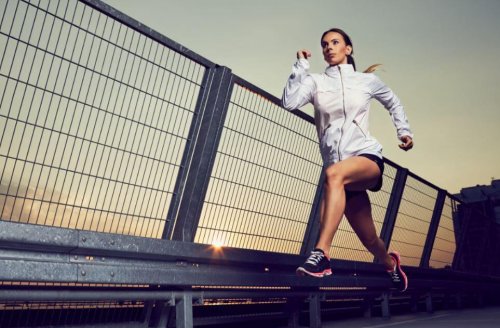Running Shoes: Types and When to Change Them

On the market you can find a huge variety of running shoes. Some brands offer you a good price, others offer aesthetics and comfort. Running entails a huge impact, that’s up to three times your body weight, on each step you take. Therefore it’s very important that you choose your running shoes well and take your needs into consideration.
What are running shoes?
Running shoes are footwear that are designed to do sports in, generally made of leather, tarp or synthetic fabric. Their name varies from, runners, to sneakers, tennis shoes, sport shoes, athletic shoes or even trainers.
To provide greater flexibility, the sole is made out of rubber. Although they were originally designed for sports, many people of all ages, from kids to teens to adults, wear them on a daily basis.
Types of running shoes
There’s a great variety of running shoes available; from different brands, gender, foot type and depending on what you will use them for. For example:
- Shoes for a competition.
- Training shoes.
- For trail, mountain or path running.
- Those which are a mix between training and competition shoes.
- Track running shoes with spikes, depending on the type of running you do.
Parts of a running shoe you must consider before you buy

When it’s time to choose a running shoe, firstly consider the following parts of the models you like:
The upper
As the name states, it’s the upper part of the shoe that goes above the sole. It might be made of several sewn parts or just one whole piece.
The outsole
This is the part that wears out first because of the contact with the surface of the floor. Verify that it’s soft and that it’s easily bendable, so that it allows your feet to move well.
The weight
Always pick the lightest running shoes. They should weight about 300 grams. Heavy running shoes may bring you discomfort and pain.
The drop
It’s the difference between the heights of the heel and the tip of the shoe. Since the drop affects your running technique, our advice is for it to be less than eight millimeters tall. This way, you’ll avoid having a huge difference between heel and toes.
Comfort
Comfort when running is extremely important. Look for hints of friction between the shoe and your foot, and avoid it as much as possible.
Shock absorption or cushioning
It’s also extremely important that your shoes have a good shock absorption, so that your foot is well supported. This is also important so that you can have good control of your heels. Cushioning helps to minimize the impact on your joints and provides you with greater resistance.
Some people opt for a minimalist running shoe that has little or no shock absorption. They prefer them because it helps them to run more naturally and give them a better perception of the ground they’re running on. There is no specific data to suggest which one is better, either a cushioned shoe or a minimal one.
The right time to change your running shoes
To determine when it’s time to change your running shoes, you must keep in mind your body weight, your foot type, where and how you put the pressure when you run, and the way you take care of them. Also consider:
- If they have cracks, stretch marks or holes.
- How many miles you’ve run in them.
- If they have broken soles.
- If you feel a strange pain on your heel or your leg bones.
Seven suggestions to keep in mind
- They must be one size up from your usual size, because feet tend to swell while on a run.
- Use socks so your feet don’t sweat too much.
- Don’t run with worn-out shoes. They don’t help with the mechanical balance of the foot, which may lead to serious injury.
- Check the sole constantly, especially if you run long distances. Keep in mind that they last from 600 to 1200 kilometers.
- To extend the “life” of your shoes buy two pairs, and change them according to the activity you are doing.
- Don’t ever use new shoes during a competition. Give them time to adjust to the shape of your foot in your daily training.
- Do a foot type test to learn about what type of shoe you should be using.
Given that running shoes are the most important item for a runner, you must choose them carefully. But, if you’re not sure what to buy or you have any doubts, talk to a person who knows what’s best for you. You may also go to a specialized store and ask the staff for some advice.
On the market you can find a huge variety of running shoes. Some brands offer you a good price, others offer aesthetics and comfort. Running entails a huge impact, that’s up to three times your body weight, on each step you take. Therefore it’s very important that you choose your running shoes well and take your needs into consideration.
What are running shoes?
Running shoes are footwear that are designed to do sports in, generally made of leather, tarp or synthetic fabric. Their name varies from, runners, to sneakers, tennis shoes, sport shoes, athletic shoes or even trainers.
To provide greater flexibility, the sole is made out of rubber. Although they were originally designed for sports, many people of all ages, from kids to teens to adults, wear them on a daily basis.
Types of running shoes
There’s a great variety of running shoes available; from different brands, gender, foot type and depending on what you will use them for. For example:
- Shoes for a competition.
- Training shoes.
- For trail, mountain or path running.
- Those which are a mix between training and competition shoes.
- Track running shoes with spikes, depending on the type of running you do.
Parts of a running shoe you must consider before you buy

When it’s time to choose a running shoe, firstly consider the following parts of the models you like:
The upper
As the name states, it’s the upper part of the shoe that goes above the sole. It might be made of several sewn parts or just one whole piece.
The outsole
This is the part that wears out first because of the contact with the surface of the floor. Verify that it’s soft and that it’s easily bendable, so that it allows your feet to move well.
The weight
Always pick the lightest running shoes. They should weight about 300 grams. Heavy running shoes may bring you discomfort and pain.
The drop
It’s the difference between the heights of the heel and the tip of the shoe. Since the drop affects your running technique, our advice is for it to be less than eight millimeters tall. This way, you’ll avoid having a huge difference between heel and toes.
Comfort
Comfort when running is extremely important. Look for hints of friction between the shoe and your foot, and avoid it as much as possible.
Shock absorption or cushioning
It’s also extremely important that your shoes have a good shock absorption, so that your foot is well supported. This is also important so that you can have good control of your heels. Cushioning helps to minimize the impact on your joints and provides you with greater resistance.
Some people opt for a minimalist running shoe that has little or no shock absorption. They prefer them because it helps them to run more naturally and give them a better perception of the ground they’re running on. There is no specific data to suggest which one is better, either a cushioned shoe or a minimal one.
The right time to change your running shoes
To determine when it’s time to change your running shoes, you must keep in mind your body weight, your foot type, where and how you put the pressure when you run, and the way you take care of them. Also consider:
- If they have cracks, stretch marks or holes.
- How many miles you’ve run in them.
- If they have broken soles.
- If you feel a strange pain on your heel or your leg bones.
Seven suggestions to keep in mind
- They must be one size up from your usual size, because feet tend to swell while on a run.
- Use socks so your feet don’t sweat too much.
- Don’t run with worn-out shoes. They don’t help with the mechanical balance of the foot, which may lead to serious injury.
- Check the sole constantly, especially if you run long distances. Keep in mind that they last from 600 to 1200 kilometers.
- To extend the “life” of your shoes buy two pairs, and change them according to the activity you are doing.
- Don’t ever use new shoes during a competition. Give them time to adjust to the shape of your foot in your daily training.
- Do a foot type test to learn about what type of shoe you should be using.
Given that running shoes are the most important item for a runner, you must choose them carefully. But, if you’re not sure what to buy or you have any doubts, talk to a person who knows what’s best for you. You may also go to a specialized store and ask the staff for some advice.
This text is provided for informational purposes only and does not replace consultation with a professional. If in doubt, consult your specialist.








